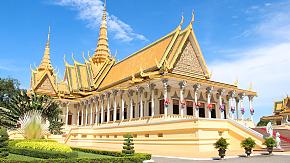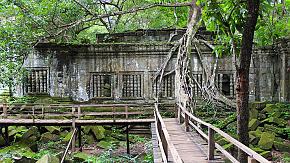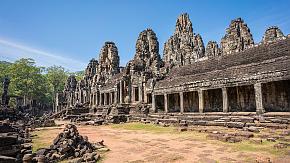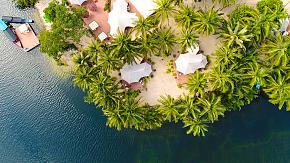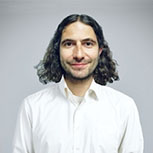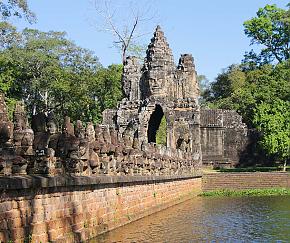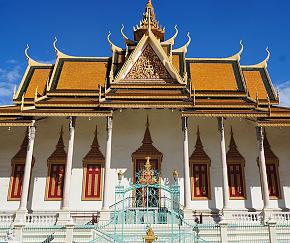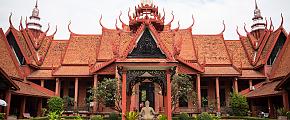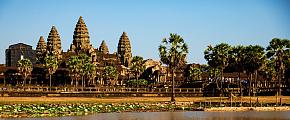Siem Reap, Cambodia, is widely known as the gateway to Angkor Wat, one of the most mysterious temple complexes in the world. Compared with the boisterous capital Phnom Penh, Siem Reap is quieter: Angkor Wat is the best-preserved temple at the site deserving of exploration; Phnom Bakheng is a perfect place for the breath-taking panorama of Angkor Wat area at sunset; also, you'll be amazed to find that the renowned site "Khmer Smile" is seated in the Bayon Temple, and the old Ta Prohm is where the film Tomb Raider was shot.
Undoubtedly, Angkor Wat and other nearby temples are must-see attractions. However, here are some essential experiences besides the temples: It's a popular place to take a tuk-tuk ride to get around the city, get a fish foot massage, watch a traditional Apsara dance, stroll in a bar street, and try eating bugs at the Old Market.
Top Attractions in Siem Reap
Being the 7th wonder in the world, Angkor Wat is a UNESCO World Heritage Site that was built in the 12th century by the Khmer civilization and located four miles north of Siem Reap, south of Angkor Thom.
See More >>- Angkor Thom
Angkor Thom is an undeniable site for most visitors taking a tour of Cambodia. Built-in the 12th century and was the last city of the Khmer empire, it was a fortified city consisting of priests' houses, court officials' palaces, and workplaces for the administrative people.
See More >> - Banteay Srei
Banteay Srei is a striking Hindu temple built in the 10th century located around 23 miles from Angkor Wat and 16 miles northeast of the temples that once belonged to Angkor Thom.
See More >> - Bayon Temple
Bayon Temple was the last stone temple built in the 12th century during the period of the Khmer empire, standing right in the center of Angkor Thom capital city in Siem Reap.
See More >> - Ta Prohm Temple
Ta Prohm Temple is a Bayon-style temple located east of Angkor Thom and southwest of East Baray. Built through the period of the 12th and 13th centuries by King Jayavarman VII, it was dedicated to his mother, a Buddhist follower.
See More >> - Tonle Sap Lake
Near Angkor Wat, Tonle Sap Lake, the Great Lake, is the largest freshwater in South Eastasia and one of the richest fishing lakes in the world.
See More >> - Baphuon Temple
Baphuon Temple was built in the middle of the 11th century prior to the construction of Angkor Wat and is located in Angkor Thom, northwest of the Bayon Temple.
See More >> - Elephants Terrace
Elephants Terrace is a huge platform running from north to south used by Angkor’s king Jayavarman VII to view his victorious army returning back home.
See More >> - Banteay Samre
Banteay Samre is a Hindu temple in Angkor, Cambodia located east of East Baray. Constructed in the 12thcentury by King Suryavarman II and dedicated to Vishnu, a Hindu god preserving the universe, the temple is built in a similar style to Angkor Wat.
See More >> - Phimeanakas
Meaning the 'celestial temple', Phimeanakas has three tires and reaches a height of around 40 meters including a platform and gallery on top.
See More >> - Terrace of the Leper King
The terrace of the Leper King is located north of the Elephants Terrace and right in the northwest corner of Angkor Thom, Cambodia.
See More >> - Bakheng Hill (Phnom Bakheng)
Located 400 meters south of Angkor Thom, Bakheng Hill is a popular tourist spot to view the sunset of Angkor Wat.
See More >> - Prasat Kravan
Prasat Kravan is a small Hindu temple built by high court officials in the 10th century and located east of Angkor Wat in Siem Reap.
See More >> - Ta Keo
The construction of Ta Keo Temple (translated as Mountains of Golden Peaks) began in 975 but it was never finished due to an allegedly lightning strike, which was deemed as a bad omen.
See More >> - Beng Mealea
Siem Reap is crammed with numerous ancient temples that overwhelm tourists a lot. Nowadays many discerning seek more peaceful and quieter attractions instead of famous crowded ones.
See More >>
















